Introduction
It’s time to talk about United States Steel (NYSE:X), which is one of my favorite cyclical stocks on the market. Not necessarily because it’s such a great company (it has a very poor long-term total return), but because it’s one of America’s oldest steel companies, which tells us so much about the state of the economy. It’s also a fantastic trading vehicle thanks to its cyclical behavior and elevated volatility.

On August 12, I wrote my most recent article on U.S. Steel, covering the impact of the Inflation Reduction Act on steel demand, among other issues.
The company’s strategic alignment with the Inflation Reduction Act and investments in sustainable steel production, coupled with investments in the electrical steel market, positions it for potential growth.
Strong quarterly results, marked by increased adjusted EPS and EBITDA, as well as positive cash flow and a healthy balance sheet, underscore its resilience.
On top of that, X is expanding its business. The company is moving into higher-margin steel products, positioning it for multiple megatrends like de-carbonization, de-globalization, and tools that can significantly leverage its margins.
As a result, the company is now the target of major takeovers. Initially, Cleveland-Cliffs (CLF) showed interest in buying, which United States Steel rejected.
Now, it’s working with multiple parties on a potential deal. Rumors are that this includes Cleveland-Cliffs (they did not comment on it in their recent earnings call), ArcelorMittal (MT), and a number of private and Canadian players.
While it needs to be seen if someone buys X and at what price (it could very well be at a juicy premium), the company is very attractive – especially as a stand-alone play.
In this article, I’ll use its recent earnings and the bigger picture to assess the risk/reward of this stock in light of challenges and opportunities.
So, let’s get to it!
A Good Quarter Despite Headwinds
Essentially, there are three key things that need to be discussed when dealing with U.S. Steel.
- The entire domestic steel industry benefits from secular growth trends like higher steel demand related to de-carbonization and de-globalization.
- United States Steel is improving its business, working on margin-enhancing products that go higher up the value chain.
- Despite long-term tailwinds, cyclical headwinds pressure the industry.
Starting with the bad news, in the third quarter, the company reported net earnings of $299 million or $1.20 per diluted share.
Adjusted for one-time items, adjusted net earnings were $350 million or $1.40 per share. This exceeded expectations, with both adjusted EPS and adjusted EBITDA of $1.40 and $578 million, respectively, driven in part by improved performance in the NAFR (North American Flat-Rolled) segment.
United States Steel
Nonetheless, it was down from $526 million in adjusted net earnings in 3Q22.
This was mainly due to pricing, as hot-rolled coil futures have come down considerably compared to prior-year levels.
TradingView (COMEX HRC Futures)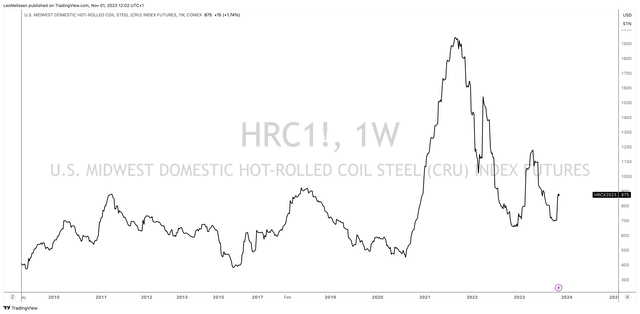
With that in mind, let’s take a closer look at the company’s segment performance.
- Flat-Rolled segment: This segment delivered a strong third quarter with EBITDA of $378 million, benefiting from higher-than-expected average selling prices, raw material tailwinds, fixed cost reductions, and lower mining-related costs. It’s a very good performance in a tough environment.
- Mini Mill segment: EBITDA declined sequentially to $84 million due to lower spot steel prices and slightly lower shipments. However, the Big River EBITDA margin would have been 15% after adjusting for nonrecurring start-up costs. More on that in a bit.
- European business: EBITDA was $10 million in the third quarter, impacted by declining prices, lower volumes, and costs related to a planned outage on one of their blast furnaces. Given the unfavorable cost environment in Europe, it’s no surprise EBITDA margins are close to zero.
- Tubular segment: Continued to deliver historically high EBITDA of $99 million at a 32% margin despite a sequential decrease driven by lower average realized prices and shipments. A big driver of this segment is a strong energy industry despite a decline in drilled rigs.
United States Steel
Having that said, the company’s balance sheet remains strong, with $5.5 billion in total liquidity, including $3.2 billion in cash.
Leverage on September 30 stood at 2x adjusted debt to EBITDA.
Buybacks are currently on pause due to a strategic alternatives review, with $125 million left on the authorized $500 million program.
United States Steel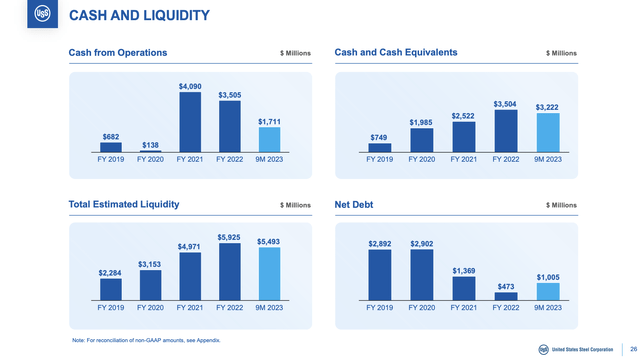
Additionally, and with regard to cyclical headwinds, the company has made some tough decisions in the third quarter, including temporarily idling its last operating blast furnace at Granite City Works due to volatile market conditions and the impact of an auto worker strike on the order book in the fourth quarter.
United States Steel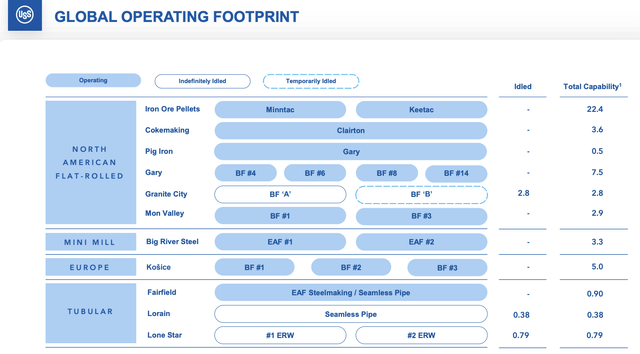
As the overview above shows, Granite City Works is now completely idled.
However, given the progress in auto union talks, I expect automotive demand to rebound rather quickly.
The New And Improved U.S. Steel
Looking beyond current cyclical headwinds, U.S. Steel is well-positioned to leverage global megatrends that favor the steel industry.
These include accelerating de-globalization, achieving energy independence in the U.S., de-carbonization efforts globally, and the application of digitization tools like AI to improve safety and efficiency.
The company believes these trends will provide strong tailwinds for the domestic steel industry.
This is what I wrote in my most recent article with regard to opportunities thanks to megatrends (emphasis added):
[…] the company’s investments in sustainable steel production, mainly in electrical steel, demonstrate its commitment to greener practices. The upcoming production of non-grain-oriented electrical steel at Big River Steel’s state-of-the-art facility is a significant milestone, as these steel types are used in generators.
US Steel’s entry into the growing electrical steel market is projected to have a 7% compounded annual growth rate, driven by high demand for advanced manufacturing and electric vehicle components.
Speaking of these tailwinds, the company’s “Best for All” strategy aims to unlock significant value in the next 12 months.
- The completion of the non-grain oriented (“NGO”) electrical steel line at Big River Steel and the upcoming launch of the dual-galvanized GALVALUME coating line (“CGL2”) are strategic initiatives that leverage de-carbonization and de-globalization trends.
- Big River 2, a state-of-the-art mini mill, is on track for a second-half 2024 start-up and will provide advanced and sustainable steel products.
The company believes the market has not fully appreciated the trajectory of its performance.
The scheduled launch of Big River 2 in 2024 is expected to create incremental strategic EBITDA and reduce CapEx by approximately $1 billion in 2024 compared to 2023.
U.S. Steel is poised to collect free cash flow and unlock stockholder value as it comes down from a period of heavy capital investment.
As the overview below shows, all of its major projects are beyond their peak in CapEx, meaning it is now increasingly benefiting from both lower CapEx and higher potential EBITDA.
United States Steel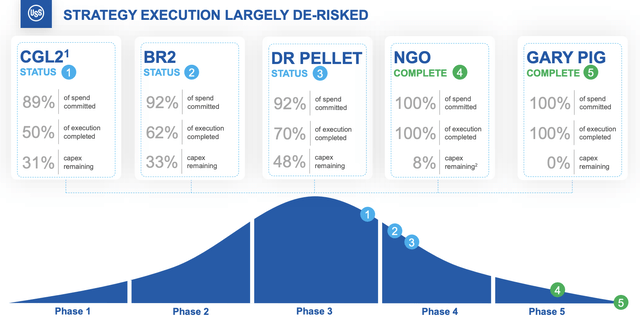
Hence, the company’s free cash flow profile has significantly improved in recent years, with an estimated annual average of about $1 billion in the 2021 to 2024 period.
United States Steel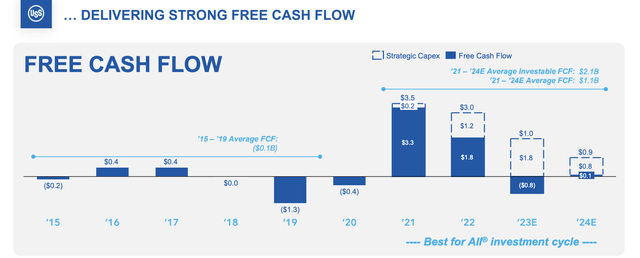
Especially after 2024, the company will benefit from the full benefits of lower CapEx and higher potential EBITDA.
Based on the current operating environment, analysts expect the company to boost its operating margin from 6.3% in 2023E to 8% in 2025. Free cash flow is expected to rebound from negative $760 million in 2023E to $560 million in 2025.
Needless to say, depending on metal prices, these numbers could be much higher – or lower.
What mainly matters is that the company has a healthier balance sheet, lower CapEx ($820 million in 2025E compared to $2.6 billion in 2023E), and tremendous earnings power.
This is exactly why it’s such a great takeover target. It has proven that it can efficiently execute growth plans, and it benefits from higher-margin operations.
The problem is putting a price target on the stock.
- Due to merger headlines, the stock is up 34% year-to-date, defying the weakness that other steel producers have had to deal with on the stock market.
- Putting a valuation on any commodity price-driven stock is tricky. After all, changes in underlying commodity prices have significant impacts on earnings.
The chart below compares the X stock price to the price of hot-rolled coil futures.
TradingView (X, COMEX HRC Futures)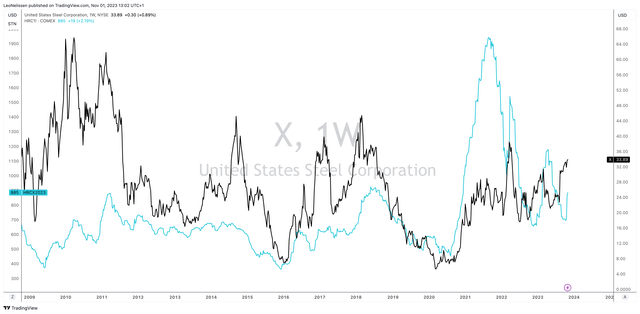
Additionally, the stock is trading at $33.90, which is slightly above the current consensus price target of $32.00.
On October 2, the company got an upgrade from Morgan Stanley, which hiked its target price from $25 to $40. I agree with that, as X is trading at just 14.6x NTM earnings.
A sustainable upswing in metal prices in 2024 could significantly fuel earnings and free cash flow.
Also, if the company were to receive another serious takeover offer, I doubt X would accept anything below $40.
Nonetheless, while I will give the stock a Buy rating, investors need to be aware that this is a high-risk play. Although M&A talks are putting a floor under the stock, we could see significant volatility if the economy deteriorates any further.
Hence, my Buy rating is a long-term rating incorporating secular tailwinds, its falling free cash flow requirements, and its improved financial health.
Takeaway
United States Steel is currently in an interesting position with a mix of challenges and opportunities.
Despite facing cyclical headwinds and a recent dip in earnings, the company has strong prospects.
Its strategic alignment with the Inflation Reduction Act, investments in sustainable steel production, and expansion into higher-margin products position it for growth.
Furthermore, the company is actively exploring potential takeover opportunities, which adds an extra layer to the bull case.
While it’s difficult to put a definitive price target on the stock, I believe that X has the potential to benefit from favorable market conditions in the not-too-distant future.
In my view, X is a high-risk, high-reward investment.
I give it a Buy rating, considering long-term potential, improving financial health, and secular tailwinds.
However, investors should remain cautious and prepared for potential volatility, particularly if the economic environment deteriorates further.
Read the full article here



